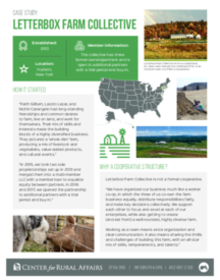Para la versión en español, por favor oprima aqui.
Established: 2013
Location: Hudson, New York
Member information: The collective has three farmer-owners/partners and is open to additional partners with a trial period and buy-in.
How it started
“Faith Gilbert, Laszlo Lazar, and Nichki Carangelo had long-standing friendships and common desires to farm, live on land, and work for themselves. Their mix of skills and interests made the building blocks of a highly diversified business. They pictured a ‘whole diet’ farm, producing a mix of livestock and vegetables, value-added products, and cultural events.”
“In 2015, we took two sole proprietorships set up in 2013 and merged them into a multi-member LLC with a member loan to equalize equity between partners. In 2016 and 2017, we opened the partnership to additional partners with a trial period and buy-in.”
Why a cooperative structure?
Letterbox Farm Collective is not a formal cooperative.
“We have organized our business much like a worker co-op, in which the three of us co-own the farm business equally, distribute responsibilities fairly, and make key decisions collectively. We support each other to focus and excel at each of our enterprises, while also getting to create (and eat from!) a well-rounded, highly diverse farm.
Working as a team means extra organization and clear communication. It also means sharing the thrills and challenges of building this farm, with an all-star mix of skills, temperaments, and talents.”
Q: Were there any helpful resources you used to answer questions you had about cooperatives?
A: Faith wrote “Cooperative Farming,” a how-to handbook on forming collaborative farm ventures. There are numerous helpful resources on cooperatives included in the handbook.
Q: As you grew and took on employees, did you face any specific challenges?
A: To be successful, we need to keep a group of talented people happy in their jobs for the long term and maintain positive and supportive working relationships. To address these challenges, we pursue and grow additional income streams that get us out of the field and build in perks.
We also try to pursue/protect a high quality of life by doing things like design efficient, manageable production systems; develop/maintain clear operating agreements; pre-plan financial, labor, and production needs preseason and spread resources evenly; budget time realistically, including time for maintaining relationships; and invest in each other’s well-being; give each other the benefit of the doubt; say good morning; say thank you; look for things to appreciate; voice criticism/requests kindly; manage our own happiness; and keep grumpiness to less than 20%.
Q: How did growth affect your farm collective?
A: We added community-supported agriculture, two new livestock enterprises, and our first employee. We installed an irrigation pond, put up new fencing, constructed a 30’ x 96’ greenhouse, purchased new tractors and equipment and learned to use them. However, even after another 25% expansion, we had not met our financial goals and needed to take another growth leap to be viable. We had little to no financial buffer, and were personally exhausted and overworked. What was our lowest risk, personally attainable, and most affordable option for growing our business? We pursued different sources of capital and modeled out different scenarios in case any of them didn’t go through.
We applied for a New York State New Farmer Grant and an additional term loan and received funding for two vegetable hoop houses, a new livestock house, a frost-free water source (new well), and bulk feed bins.
Advice for others
“Every farm works with its unique advantages and setbacks. Likewise, each one of us has a unique blend of struggles and privileges. I want to note there is race and class privilege in our story—ways we had to access resources through our families, and some skills we had gained through education. However, I am heartened that many of the tools we were able to learn and use are or can be made available to all, including shameless bravado. You, too, can fake it till you make it.”
Types of cooperatives:
- Retail
- Worker
- Producer
- Service
- Housing
This project was developed using a U.S. Department of Agriculture Rural Development Socially Disadvantaged Groups Grant. The Center for Rural Affairs is an equal opportunity provider and employer.


